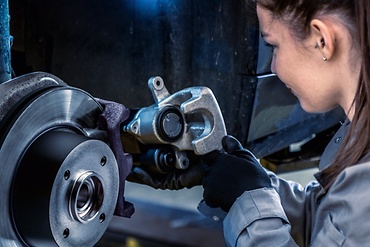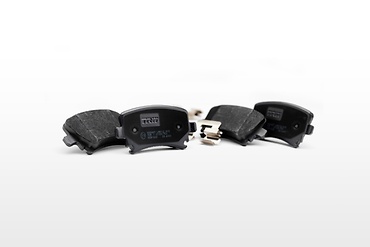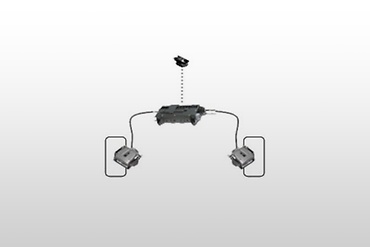The increasing number of electric systems such as lane assist, park assist, adaptive cruise control, emergency brake assist or electric parking brake present workshops with ever increasing challenges for diagnosis and repair.
Work on these systems is often only possible with the help of a suitable diagnostic tool.
In addition to error diagnostics, the handling of these systems often requires additional care, e.g., when testing an electric parking brake on a rolling test bench.
Due to the test bench detection, the electric parking brake from TRW identifies the test bench approx. 3 - 5 seconds after the rear axle enters the test bench, with the ignition on and the auto-hold function deactivated (does not work on four-wheel drive brake test benches). The EPB control unit detects that the front wheels are at a standstill and that the rear wheels are rotating with a constant speed between 2 and 6 mph. This mode is indicated to the driver on the instrument panel, either with a signal light or with a notice that the vehicle is in test bench mode.
How-to-guide
The test bench modes can differ greatly, however, depending on the vehicle manufacturer! The following videos illustrate the respective test sequence for electric parking brakes on the rolling test bench. These are examples which can vary through software updates or model changes.
To avoid damage to the vehicle, please find out about the exact test process for the respective vehicle before entering the rolling test bench.

- Enter the rolling test bench with the rear axle
- Test stand starts up
- The rear wheels move at a constant speed, rolling test bench must not exceed 4mph, front wheels are stationary
- After 3 to 5 seconds switch-over to test bench mode – prerequisite: ignition on
- Control unit detects test bench mode
- With each short activation of the button (up to 4 times) the piston is retracted a short defined distance and the brake is gradually closed until the blocking limit has been reached
- This can be followed on the indicator as an increasing brake force
- Test completed – exit from the rolling test bench

- Enter the rolling test bench with the rear axle
- Test stand starts up
- The rear wheels move at a constant speed between 2 and 6 mph, front wheels are stationary
- After 3 to 5 seconds switch-over to test bench mode – prerequisite: ignition on
- Control unit detects test bench mode
- With each short activation of the button (up to 3 times) the piston is retracted a short defined distance and the brake is gradually closed until the blocking limit has been reached
- This can be followed on the indicator as an increasing brake force
- Test completed – exit from the rolling test bench

- Enter the rolling test bench with the rear axle
- Test stand starts up
- The rear wheels move at a constant speed between 2 and 6 mph, front wheels are stationary
- After 3 to 5 seconds switch-over to test bench mode – prerequisite: ignition on
- Control unit detects test bench mode
- With each short activation of the button (up to 3 times) the piston is retracted a short defined distance and the brake is gradually closed until the blocking limit has been reached
- This can be followed on the indicator as an increasing brake force
- Test completed – exit from the rolling test bench

- Enter the rolling test bench with the rear axle
- Test stand starts up
- The rear wheels move at a constant speed between 2 and 6 mph, front wheels are stationary
- After 3 to 5 seconds switch-over to test bench mode – prerequisite: ignition on
- Control unit detects test bench mode
- With each short activation of the button (up to 3 times) the piston is retracted a short defined distance and the brake is gradually closed until the blocking limit has been reached
- This can be followed on the indicator as an increasing brake force
- Test completed – exit from the rolling test bench

- Enter the rolling test bench with the rear axle
- Test stand starts up
- The rear wheels move at a constant speed between 2 and 6 mph, front wheels are stationary
- After 3 to 5 seconds switch-over to test bench mode – prerequisite: ignition on
- Control unit detects test bench mode
- With each short activation of the button (up to 3 times) the piston is retracted a short defined distance and the brake is gradually closed until the blocking limit has been reached
- This can be followed on the indicator as an increasing brake force
- Test completed – exit from the rolling test bench

- Deactivate automatic rolling
- Enter the rolling test bench with the rear axle
- Engine off; wait 2 seconds
- Ignition on
- Activate rolling
- Test stand starts up
- The rear wheels move at a constant speed between 2 and 6 mph, front wheels are stationary
- After 3 to 5 seconds switch-over to test bench mode – prerequisite: ignition on
- Control unit detects test bench mode
- With each short activation of the button (up to 3 times) the piston is retracted a short defined distance and the brake is gradually closed until the blocking limit has been reached
- This can be followed on the indicator as an increasing brake force
- Test completed – exit from the rolling test bench
Note: If the rolling test bench cannot be switched off, follow this advice:
- Move the rear axle to the roller of the test bench
- Turn off the engine (ignition off) and let the vehicle roll into the rolling test bench
- Start after 2 seconds
- Carry out the test as described above
ZF Aftermarket product range
Discover the complete portfolio of brakes in our product catalog.


